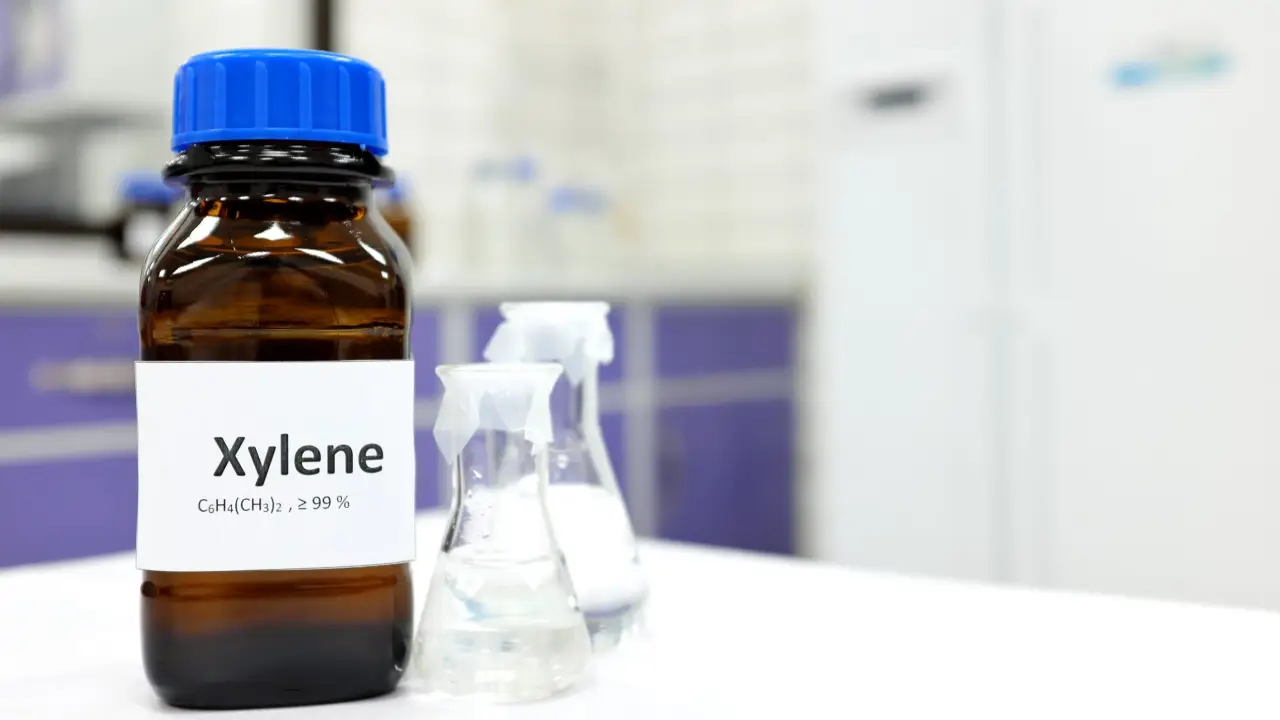Xylene Supplier from Turkey and Dubai-UAE

Description of Xylene
Xylene, also known as dimethyl benzene, is an aromatic hydrocarbon widely used as an industrial solvent and chemical intermediate. Its chemical formula is C₆H₄(CH₃)₂, consisting of a benzene ring with two methyl groups attached. Depending on the position of these methyl groups, three isomers exist: ortho-xylene (o-xylene), meta-xylene (m-xylene), and para-xylene (p-xylene).
dimethyl benzene is a colorless, flammable liquid with a sweet, characteristic odor. It is valued for its excellent solvency, moderate evaporation rate, and ability to dissolve resins, coatings, rubber, and polymers, making it indispensable across multiple industrial sectors.
History of Xylene
Xylene was first isolated in 1850 by French chemist Auguste Cahours from wood tar. Initially obtained from coal tar, its production shifted to petroleum refining as the petrochemical industry developed. By the mid-20th century, Xylene became essential in manufacturing synthetic fibers, plastics, coatings, and paints, serving as a key feedstock in the global chemical industry.
Physical and Chemical Properties of Xylene
Physical Properties
-
Appearance: Clear, colorless liquid with a sweet, aromatic odor.
-
Density: Approximately 0.86 g/cm³ (lighter than water).
-
Boiling Point: Ranges from 138°C to 144°C, depending on isomer type.
-
Melting Point: Varies between −47.9°C (m-xylene) and 13.3°C (p-xylene).
-
Solubility: Practically insoluble in water but highly soluble in organic solvents such as alcohols, ethers, and acetone.
-
Viscosity & Volatility: Moderate viscosity and controlled volatility make it ideal for coatings and solvent applications.
Chemical Properties
-
Molecular Weight: 106.16 g/mol
-
Structure: Benzene ring with two methyl groups (ortho, meta, or para positions).
-
Flammability: Highly flammable, flash point 25–30°C.
-
Reactivity: Stable under normal conditions but reacts with strong oxidizing agents like nitric acid or chlorine.
-
Hydrophobic Nature: Non-polar, enabling dissolution of oils, fats, and resins effectively.
Types and Grades of Xylene
1. o-Xylene
Used primarily in the production of phthalic anhydride, a vital intermediate for manufacturing plasticizers, dyes, alkyd resins, and unsaturated polyester resins. Ortho-Xylene’s applications span the PVC, coatings, and pigment industries.
2. m-Xylene
Employed in the synthesis of isophthalic acid, which is used to produce high-performance alkyd and polyester resins. These resins provide superior durability and chemical resistance, making m-Xylene essential in paint, coating, and adhesive manufacturing.
3. p-Xylene
The most commercially important isomer, para-Xylene, is the primary feedstock for purified terephthalic acid (PTA) and dimethyl terephthalate (DMT) — both used in the production of polyethylene terephthalate (PET) for textiles, bottles, and films.
4. Mixed Xylene
A combination of all three isomers with ethylbenzene, Mixed dimethyl benzene a versatile solvent widely used in paints, coatings, rubber processing, and gasoline blending due to its excellent solvency and drying characteristics.
5. High-Purity Xylene
High-purity grades, especially high-purity p-Xylene, are essential for industries demanding top-grade PET, polyester fibers, and precision plastics.
Applications and Uses of Xylene
1. Paints, Coatings, and Inks
Dimethyl benzene is one of the most widely used industrial solvents for dissolving resins and binders in paints and coatings. Its controlled evaporation rate ensures smooth film formation and prevents defects. Xylene is preferred in automotive, marine, and industrial coatings, as well as in printing inks, for its excellent solvency and finish quality.
2. Adhesives and Sealants
Due to its ability to dissolve polymers and resins, Dimethyl benzene is used in manufacturing rubber-based and contact adhesives. It improves viscosity control and adhesion in sealants used in construction and automotive applications.
3. Rubber Industry
In the rubber and elastomer sector, Xylene acts as a solvent for breaking down natural and synthetic rubber, improving flexibility, strength, and processability. It is vital in manufacturing tires, hoses, belts, and gaskets.
4. Leather Industry
Xylene is used as a degreasing and finishing agent to remove fats and oils from leather surfaces. It also enhances color uniformity and surface gloss in high-quality leather products like shoes, bags, and upholstery.
5. Chemical Manufacturing
Xylene serves as a feedstock for critical petrochemical intermediates such as PTA, DMT, and phthalic anhydride. These intermediates are the backbone for producing polyesters, plasticizers, and resins used across the packaging, textiles, and coatings industries.
6. Fuel Additive
Mixed Xylene is blended into gasoline to increase its octane rating and enhance combustion efficiency. It improves engine performance and fuel economy.
7. Industrial Cleaning and Degreasing
Thanks to its strong solvency, Dimethyl benzene is an effective cleaning agent for removing oils, waxes, and residues from machinery and automotive components.
8. Laboratory and Medical Applications
In histology and pathology, Xylene is used for tissue clearing and slide preparation. It dissolves paraffin and ensures clear microscopic imaging, vital for diagnostic procedures.
9. Resin and Plastic Production
Xylene is integral in producing polyester, alkyd, and epoxy resins, which are further used in fiberglass, laminates, and reinforced plastics.
Handling, Storage, and Transportation of Xylene
Xylene must be handled in well-ventilated areas away from ignition sources. Personnel should use protective gloves, goggles, and respirators when exposed. Storage tanks should be grounded and kept in cool, dry locations. During transportation, flammable-liquid labels are mandatory, and containers must comply with international IMDG and ADR standards.
Packing Details and Container Loading of Xylene
Packing Options
-
Bulk Transport: Available in ISO tanks or rail tank cars for large-scale operations.
-
Drums: 200 L steel drums for medium-volume applications.
-
Cans: 5 L or 20 L metal cans for smaller industries.
-
Bottles: HDPE or glass bottles for laboratory-grade material.
Container Loading
-
20-ft Container: Approximately 16 – 18 tons of Xylene (in drums).
-
ISO Tank Container: Up to 24 tons net weight capacity.

